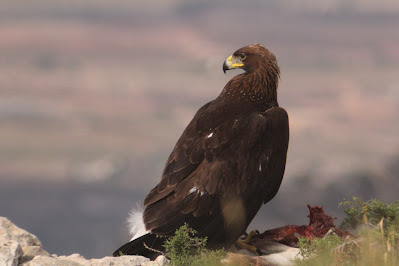Golden Eagles in the Sierra Espuna
Today was finally the day. It was a birthday gift from my family: visit the Sierra Espuna to photograph the golden eagle, the most powerful avian predator of Eurasia west of the Sea of Okhotsk.
With a wingspan of 2 meters and talons the length of a tiger's claws, this is certainly a majestic and beautiful bird of prey. I always wanted to see it. And now, when presented with an opportunity to see it so close, how could I possibly pass this up?
The day prior to the ascent into the mountains, I took the image I was looking forward to since the last time I was here, when I did see the golden eagles but they never came close in a murky environment. A picture of the Morron de Espuna looming above Alhama de Murcia at sunset. At 1583m high, the highest mountain in the region. There were bee-eaters calling nearby.
And the next day, it was time :)
The trip required a 6am start on the 12th September 2024. Which needed me to wake up even earlier, at around 5:30 am.
The location looked unremarkable, just a mountain nearby, and not even the tallest one. The stars overhead, however, were beautiful. I entered the hide, and began to wait. Getting good photos of such a wary bird is near-impossible otherwise. I sat down, began writing something in a notebook, and watched the mountains slowly wake up.
And for a long time, nothing happened. As I waited and waited, two marsh harriers drifted past and some chough were circling in the distance, as well as a few griffon vultures. For a long time, nothing happened.
As I watched, a pair of ravens appeared at close range. Despite their massive bill, the corvids only took small pecks at the carcass located nearby.
They did this for some time, until an adult golden eagle came out of nowhere, flushed the ravens off the carcass, and began staring in all directions. And it was close. As close as 15 meters away from me. It could not see me, but I could see it, with the unaided eye, extremely well.
I was stunned. By this point, 5 hours had elapsed since I entered the hide. I was already starting to give up on seeing them today. And, yet, here it was. The eagle by this point had identified the area as safe, and began picking at the carcass.
I watched, stunned. I was told earlier that this bird, one of the pair that has an eyrie just nearby, is exceedingly old- over 20 years old, in fact.
As the eagle fed, I periodically noticed that there were griffons circling nearby. I hoped that one of them would perch when the eagle left, but, as I later found out, the eagles turned out to be greedy and did not leave the carcass unattended for more than 5 minutes for the next 5 hours!
After the eagle departed, I saw two more eagles flying through the sky. Another adult took the place of the former at the carcass, and proceeded to eat it. I hoped that this was another of the pair, but I was not paying attention to any possible size differences. IT did not stay for long, however, and soon took off and began flying in front of the hide.
Another bird soon landed at the carcass. This bird looked noticeably different. It was a golden eagle but, compared to the two others, had different-coloured plumage and looked significantly more 'fresh'.
As I later found out, this young bird was born this year. It then spent the next three hours almost without interruption with the carcass, only leaving for short periods of time.
One such time was when the eagle became disturbed by something nearby. I soon saw the source of the disturbance- a family of barbary sheep. One of them was aggressive, and kept charging at the young eagle, but seemed to be intimidated by its large size.
Eventually it did chase the eagle off, and the barbary sheep also, I thought, prevented an exceedingly close griffon vulture from landing at the carcass, which was circling over the area intently. The barbary sheep, I felt, was lucky. If it was one of the adults instead and the adult was in a bad mood, the sheep would have stood no chance- golden eagles have been known to kill far more fearsome prey than that, especially in Asia where they are known to hunt wolves. The eagle sat on a cliff for some time, and then flew back to the carcass.
It re-settled at the carcass, and then spent the next hour pecking at it. A griffon vulture circled above with interest, but the eagle did not give up its space.
After 10 hours in the hide, I left. Beyond satisfied.


















Comments
Post a Comment